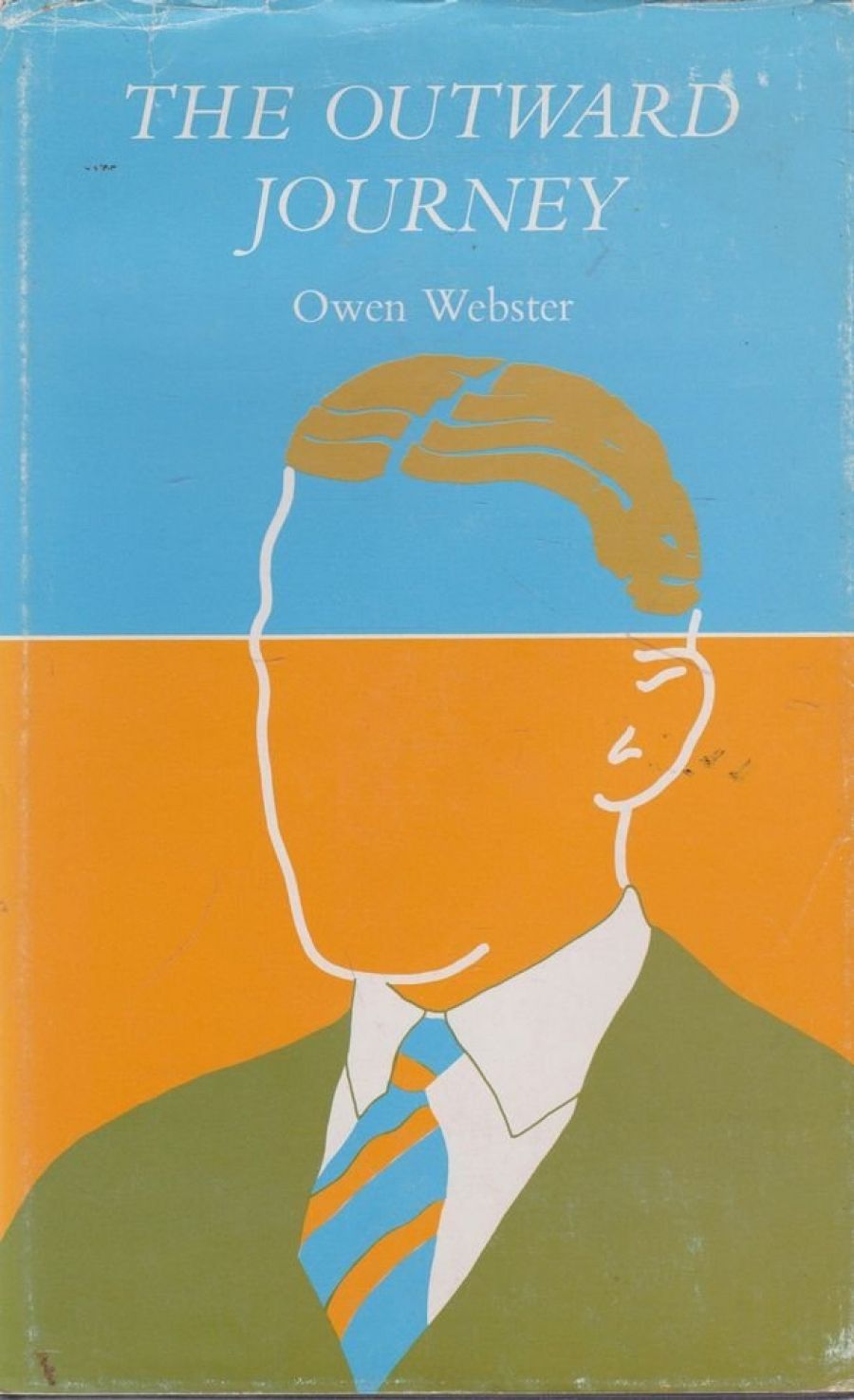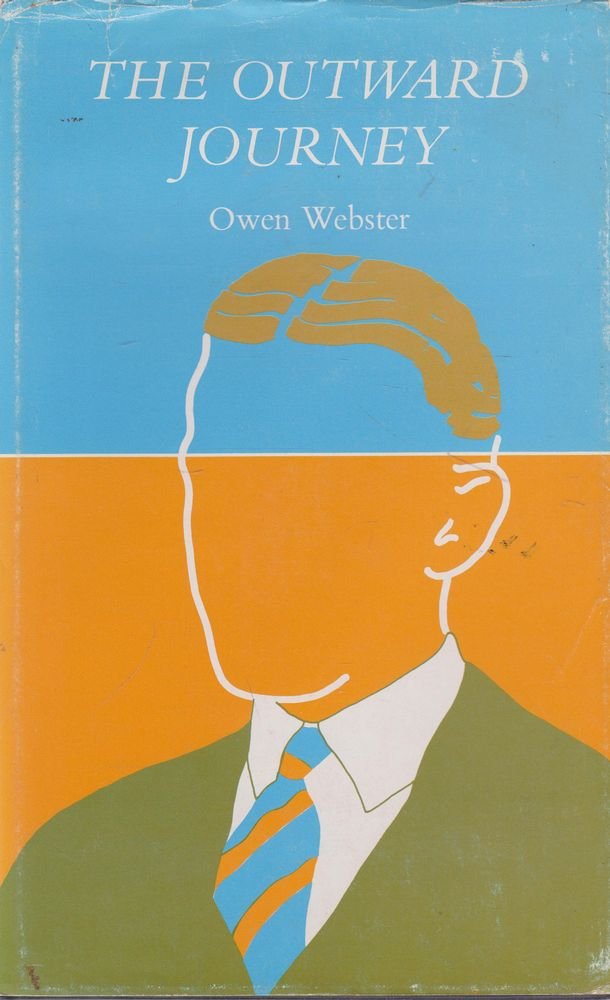
- Free Article: No
- Contents Category: Biography
- Review Article: Yes
- Article Title: Slippery as a Melon-seed
- Online Only: No
- Custom Highlight Text:
‘Memory as slippery as a melon seed.’
So wrote Frank Dalby Davison in a letter to his mother in 1945. And memory in its trickiest forms is before the reader’s mind throughout Owen Webster’s semi-, demibiography of Davison -·’semi’ because, though Webster described this book as a ‘non-fiction novel’ it relies so heavily on Davison’s fiction for ‘facts’ that one might better call it ‘fictional biography’: ‘demi’ because it deals only with the first thirty years of Davison’s life (and with his forbears). Webster. a most assiduous collector of material, had planned a second volume (predictably with the provisional title of The Inward Journey). but died in 1975 before completing his work.
- Book 1 Title: The Outward Journey
- Book 1 Biblio: ANU Press
- Book 1 Cover Small (400 x 600):

- Book 1 Cover (800 x 1200):

‘Go on, read ’em. I’ll never make a writer.’
They’ll make interesting wallpaper. The outburst, we are told, was about Davidson’s first batch of rejection slips. But that was in 1918, and the rejections were almost certainly deserved. We are given many such glimpses, true or questionable, into the formative years of the author of Man-shy Dusty, The Road to Yesterday, and The White Thorntree. And, despite both quibbles and reservations. I firmly believe that any book which throws light on a writer of such distinction is a valuable book. But …Well, let’s not raise the ‘buts’ yet.
Davidson is not born until page 40 and does not even share centre stage until page 60. However, the first three chapters are intermittently worthwhile social history, especially valuable for the portrait that merges of Jane Brown. Davidson’s formidable grandmother.
Jane Brown apparently arrived in Victoria in the mid-1850’s – we get (through some dozen readable letters from her family England) disconnected glimpses of family difficulties which suggest a ‘never darken my door again’ dismissal by her mother. She married a likeable ne’er do-well cook, Tom Davidson. Her first two babies died of dysentery in Geelong where the untreated river was the suspect water supply. Her sixth child, Fred, was born in Ballarat, her husband by then probably away as a station cook. Her daughter-in-law Amelia once ventured to ask her, ‘Did you love your husband?’ Jane’s answer ‘He was the father of my children.’ Jealous of Amelia as a rival for the affection of Fred, her only surviving son, Jane did not attend the wedding, but prepared their evening meal in Fred’s new home. After the meal, Jane was unwilling to depart, and the children could not raise the effrontery to suggest it. Not until her daughter came over, close to midnight, and urged her mother to come home with her, was the bridegroom left alone with his bride. Fred was later to say that his mother Jane had spoilt the first ten years of his married life with Amelia.
Perhaps Webster spends too much space being hard on Fred Davison, father of the author, (Frank Dalby Davidson, incidentally, was a name Fred’s son adopted only in the 1930s; his parents had called him Frederick Douglas.) Frederick senior is presented as an oracular, self-nominated prophet of Australian parochialism, fecklessly moving from one job or place to another. There does seem to be some small evidence for this picture but one can infer that, despite all, he was likeable in a Jaunty way, and that his Australianism was in part a reaction against toadying to England. And luckily, he had a penchant for bringing out short-lived magazines, and he demanded stories, verse, narrative, anything from his son to help fill them. Frank, both by Fred’s example and by inclination, was committed to writing early in life.
Webster traces the family moves from one Melbourne suburb to another until young Frank (I’ll call him that) left Caulfield State School aged 12. But though there are facts galore, the experience of those years is evoked effectively from letters Frank and his mother Amelia exchanged in 1945-50, or from other letters by Frank, or in the ABC TV interviews he did with Webster in 1969.
In 19806, there was much crying of ‘Go on the land, young man’. As Frank later put it:
My father, who was…essentially an urban man…listen to this cry. And decided that I would answer it.
And young Frank, aged 13, was put for a year on a selection at what is now Kinglake West – an experience the memory of which comes alive so movingly but unsentimentally in his autobiographical story, ‘The Road to Yesterday’, must quoted here. But later, when he had ten months on a station in Gippsland, there is no one story to quote and webster has only three lines about it. Those early spells on the ;and did not last: in 1909 restless Fred migrated with his family to the U.S.A and soon his son was a printer’s apprentice.
The young Davidson’s first printed work was four lines of verse for the family Christmas card. Within four years he was writing much verse, mostly reflecting homesickness for Australia (The ‘Roo Thuds’, ‘The Magpie’. ‘My Native Land’). At an Australia Day dinner in Chicago, ‘My Native land’ was sang as a chorus, led by a young architect, Walter Burley Griffen. But one doubts the appropriateness of printing pages of this verse juvenilia. One scrap of prose, ‘Bill’s Bush Fire’, callow as it is, is of more interest.
Farming, nostalgia for Australia, apprenticing himself to writing as well as printing – these were forming the 21-year-old Davidson when the war began.
Webster’s book goes on to an account of Davidson’s four years in the British Army; of his marriage to his first wife (known as Kitty or Kay) near Aldershot; of his four years from 1919 to 1923 as a soldier settler in Injune, north of the Maranoa in south-central Queensland, and of the failure of that enterprise. The book ends with Davison aged 30, retreating to Sydney to work with his father’s real estate business and on one of his magazine projects.
There is, unfortunately, something shadowy about the portrait Webster paints of the young man. There is a little sense of Davison’s immediate experience in the writing. We ar given bits of half dozen pieces of prentice writing he did for two of his father’s magazines under such pseudonyms such as ‘T. Bone’. But most of Webster’s account depends heavily on the memory of older people many years later: it depends on Davison’s own very fine short stories of the late thirties, on the T.V. interviews of 1969, and on Kay Davison’s conversations and communications with Webster in 1970-71. This is fair enough, but, if memory is ‘as slippery as a melon seed’ – and who can doubt it – we may be permitted to have some reservations about the impressions this book gives us. Memory, of course, especially when it takes the form of searching imaginative fiction, can often convey much more than the raw facts of contemporary diary jottings. But there are difficulties.
Four years of war is a case in point. We know that Davison saw trench warfare in Loos in 1915; we know he saw ‘mounted action’ on the Somme and at Arras. But we are told no more of where he was or what it meant. The only passages with any snse of actual experience are lengthy quotations from a short story, ‘Father and Sons’, written in 1939 when Davison’s attitude to war was far more sceptical than in 1916. And that story, though it may well be based on the actual death of a friend in the trenches, is presented as a factual account of Davison’s experiences – and then Webster corrects ‘inaccuracies’. The same acceptance of fiction as fact is, unbelievably, true of Webster’s account of Davison’s relations with his bride – details from The White Thorntree, half a century later are quoted five times in explanation of circumstances that are explicitly different.
More importantly, Webster repeatedly quotes at length from Davison’s short stories as evidence of his experience of the details of his experience in those four years of trying to buck the impossible odds against success on the Queensland settler’s block. These stories, written in the 1930’s, published as The Woman at the Mill (1940) and revised for The Road to Yesterday (1964), are among Davison’s best work, and it is a great pleasure to be recalled to them by lengthy quotation. They certainly give us a moving sense of the frustration, both economic and human, not only of those sparse years but of the man’s longer past experience – and of the illusion precedent to that frustration. It is disconcerting, however, to have these varied and powerful stories introduced to make a merely factual, documentary point about the details of the author’s experience – about what size his dam was or whether the fence posts were in a straight line, or his view of his (actual) near neighbour.
Webster fails to quote the ‘Author’s Note’ to the 1940 collection:
My frequent use of the first person might suggest, to the uninhibited, that I am writing from life. Nothing could be further from the truth. Life doesn’t transpose like that…
In that note, Davison goes too far, and in 1964 he conceded that the stories were autobiographical ‘to a very limited degree’. In one sense, any worthwhile fiction is, of course, ‘writing from life’, and Davison’s fiction is intimately based on a wisdom and knowledge rooted in the reality of particular place and time. But it is the literal following of detail which Davison denies and Webster practises.
Again, the large contribution of Kay Davison – Webster cites her conversation of written reminiscence some 35 times in the notes – does give us a sense of her view of those difficult Injune years, but it is accepted too readily as the full story. It is not that she is unable to laugh at herself – she can tell of her first arrival at the outback store near Injune when she asked ‘Where can I get a taxi?’ But it remains a partial view and one cannot help wondering why Webster never questions her view of events. That view is qualified by implication in the quotations from Davison’s fiction – and that, at least, is some justification for the use Webster makes of them.
It should be added that Webster’s background to the story of the Injune settlement as a whole is excellent – the concatenation of errors, the short-sighted refusal of the Queensland Government officers and politicians to heed advice that only large blocks would be viable, that the rainfall was less than they promised, that bore water was no solution, that prickly pear was a great hazard (still a few years from C.S.I.R’s success with cactoblastis), that access was inadequate – the list seems endless, it is well documented. It is no wonder that Davison ‘greener than the herbage’, failed. But then he said in 1969:
It’s possible that I wasn’t a farmer to begin with. I was only a crazy writer from the very start.
For all my reservations about Webster’s first volume, I still feel it a great loss that we shall not have his view of the remaining half a century of Davison’s life. But, since his life was to be divided into two volumes, it’s a pity, that this volume ends with his defeat in circumstances where victory was impossible anyway, rather than with his victory half a dozen years later – the recognition of Man-shy. After all, the subject of this book is a writer, and far from a crazy one.


Comments powered by CComment